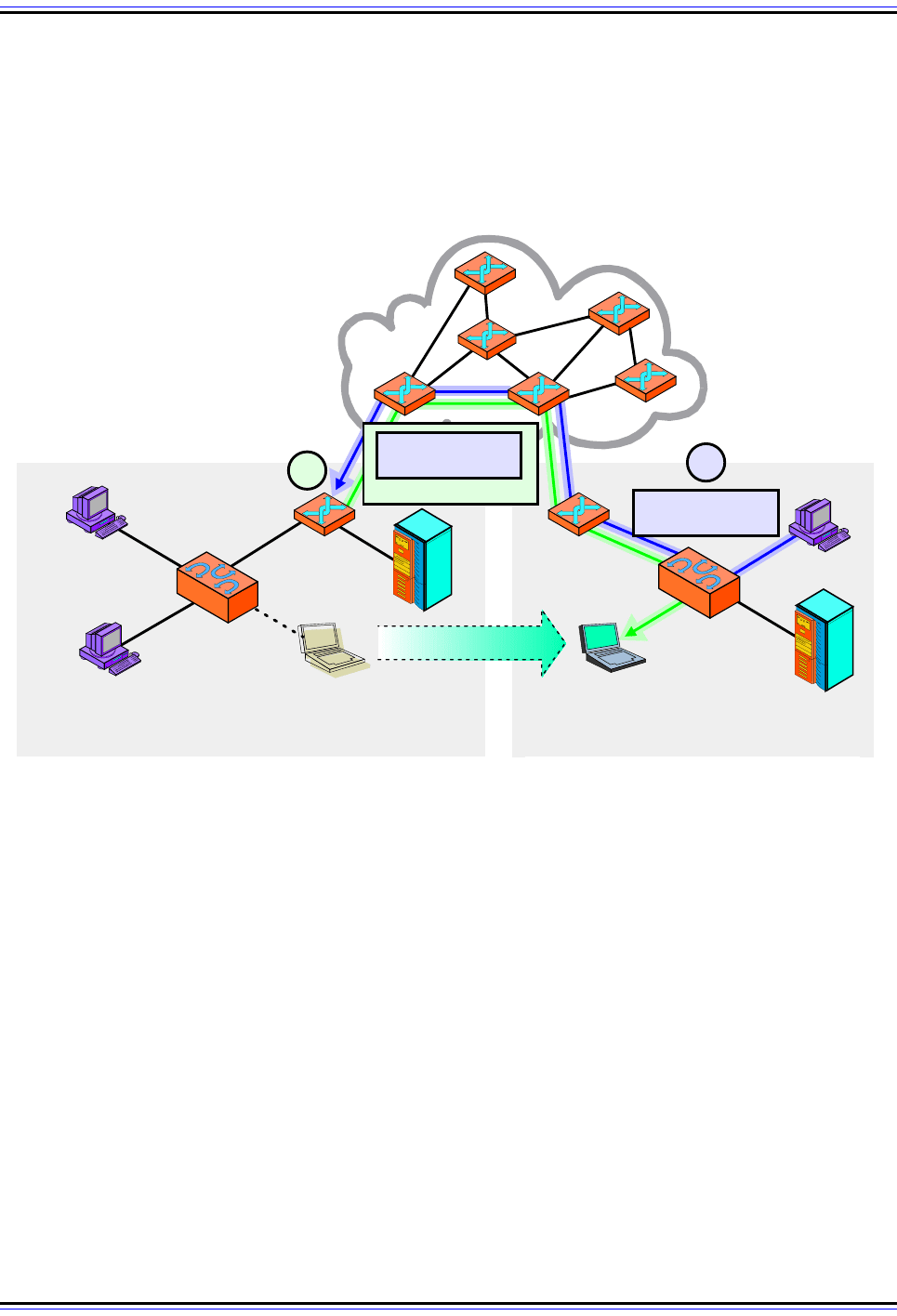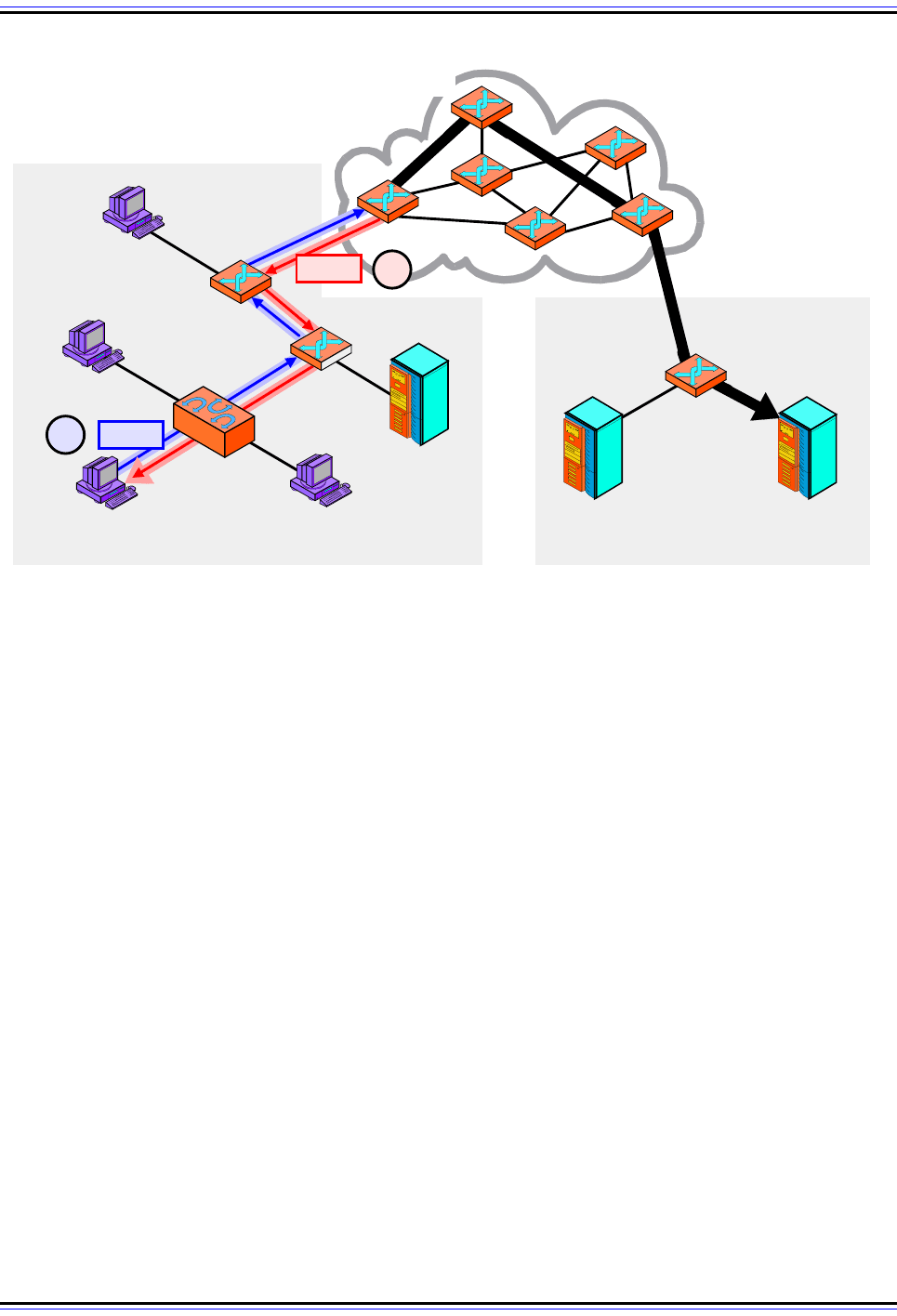Charles M. Kozierok The TCP-IP Guide
Подождите немного. Документ загружается.


The TCP/IP Guide - Version 3.0 (Contents) ` 601 _ © 2001-2005 Charles M. Kozierok. All Rights Reserved.
☯ Sending Device On Foreign Network: The greatest inefficiency results when the
sending device is actually on the foreign network that the mobile node is visiting. If
device A is on the mobile node's current network in Tokyo, it must send all the way to
London and then have the result forwarded all the way back again to Tokyo. Without
Mobile IP, all we would need to do is use ARP and then deliver directly at layer two
without routing needed at all! This scenario is illustrated in Figure 136.
Unfortunately, the “worst case scenario” outlined in the last bullet point is one that occurs
quite often. It's common for a mobile device to connect with a foreign network specifically to
communicate with the hosts on that network
Implications of Reverse Tunneling
To make matters worse, consider what happens if reverse tunneling is used! Here,
tunneling is done not just for datagrams sent to the mobile node but sent from it as well. In
our “worst case” example, a request/reply pair from the mobile node to another device on
the foreign network requires two complete round-trips from Tokyo to London and back.
Clearly, this is far from ideal.
Figure 136: A Mobile IP Inefficiency “Worst Case Scenario”
This diagram show the worst possible case of Mobile IP inefficiency: when a device on the foreign network
where the mobile is located tries to send to it. The sender here, 210.4.79.11, uses the mobile node’s home
address, so the transmission must be routed all the way back to London and then forwarded back to Tokyo,
even though the two devices might be sitting on the same desk!
Foreign Network (Tokyo)
210.4.79.0/24
Home Network (London)
71.13.204.0/24
Mobile Node
Home Location
Home Address 71.13.204.20
Home
Age nt
Mobile Node
Foreign Location
Care-Of Address 210.4.79.19
Foreign
Age nt
210.4.79.2
Tunnel To: 210.4.79.19
210.4.79.11
#1
To: 71.13.204.20
From : 210.4.79.11
To: 71.13.204.20
From : 210.4.79.11
#2

The TCP/IP Guide - Version 3.0 (Contents) ` 602 _ © 2001-2005 Charles M. Kozierok. All Rights Reserved.
Inefficiency is an Inherent Part of Mobile IP
There really isn't any solution to this problem within Mobile IP itself; it's just a natural conse-
quence of how the protocol works. The only way to really improve things is to “hack in” a
solution that ultimately boils down to one of the two options we always have in IP without
mobility support: we either decide to give the mobile device a temporary real IP address on
the foreign network, or we use a host-specific route for the mobile device while on the
foreign network.
We've already seen that these both have problems, which is why Mobile IP was created in
the first place. There may be situations, however, where efficiency is more important than
the transparent portability that Mobile IP provides. For a long-term deployment on a foreign
network far from the home network, or for applications where efficiency is paramount, it may
make sense to employ one of these techniques. For example, a corporation that has a
small number of offices in different cities connected using the Internet might set up special
routing. This would let mobile devices visiting from other cities talk directly to nodes local to
the foreign part of the network without being routed across the Internet.
Key Concept: Since datagrams are sent to a mobile node at its home address, each
datagram sent to the mobile device must first go back to its home network and then
be forwarded to its current location. The level of inefficiency that results depends on
how far the sender is from the mobile’s home network. The worst case actually occurs if the
sender and mobile are on the same foreign network, in which case each transmission must
make a round-trip to the mobile’s home network and then back again. This is an inherent
part of how Mobile IP and cannot readily be rectified.
Mobile IP Security Considerations
Security is always a concern in any internetworking environment these days, but is
especially important with Mobile IP. There are a number of reasons for this, which are
related to both how the protocol is used and the specific mechanisms by which it is
implemented.
In terms of use, security was kept in mind during Mobile IP's development because mobile
devices often use wireless networking technologies. Wireless communication is inherently
less secure than wired communication, because transmissions are sent “out in the open”
where they can be intercepted. It's also easier for malicious users to possibly disrupt the
operation of wireless devices than when they connect using wires.
In terms of operation, Mobile IP has a number of risks due to it using a registration system
and then forwarding datagrams across an unsecured internetwork. A malicious device
could interfere with registration process, causing the datagrams intended for a mobile
device to be diverted. A “bad guy” might also interfere with the data forwarding process
itself, by encapsulating a bogus datagram to trick a mobile node into thinking it was sent
something that it never was.

The TCP/IP Guide - Version 3.0 (Contents) ` 603 _ © 2001-2005 Charles M. Kozierok. All Rights Reserved.
Mobile IP Security Provisions
For these reasons, the Mobile IP standard includes a limited number of explicit provisions to
safeguard against various security risks. One security measure was considered sufficiently
important that it was built into the Mobile IP standard directly: authentication of Registration
Request and Registration Reply messages. This authentication process is accomplished in
a manner somewhat similar to how the IPSec Authentication Header (AH) operates. Its goal
is to prevent unauthorized devices from intercepting traffic by tricking an agent into setting
up, renewing or canceling a registration improperly.
All Mobile IP devices are required to support authentication. Nodes must use it for requests
and agents must use it for replies. Keys must be assigned manually as there is no
automated system for secure key distribution. The default authentication method uses
HMAC-MD5 (specified in RFC 2403), which is one of two hashing algorithms used by
IPSec.
Protecting Against Replay Attacks
Another concern is a security problem called a replay attack. In this type of attack, a third
party intercepts a datagram, holds onto it and then re-sends it later on. This seems fairly
harmless, but consider the importance of timing. Imagine a mobile node registers with its
home agent, then later returns home and deregisters. If a malicious device captures a copy
of the original Registration Request and re-sends it, the home agent might be fooled into
thinking the node has traveled away from home when it has not. It could then intercept the
forwarded datagrams.
The Identification field used in Registration Request and Registration Reply messages is
designed to prevent replay attacks. Since each request has a different Identification
number, nodes and agents can match up requests with replies and reject any datagrams
they receive that are repeats of ones they have seen already. The Mobile IP standard also
specifies alternative methods for protecting against replays.
Limitations of Mobile IP Authentication
While Mobile IP includes authentication measures for registration messages, it does not for
other types of messages. It also doesn't specify authentication of encapsulated datagrams
being forwarded from the home agent to the mobile node. Encryption is also not provided to
safeguard the privacy of either control messages or forwarded datagrams. The obvious
solution when stronger assurances of privacy or authenticity are required is to make use of
the IPSec Authentication Header (AH) and/or Encapsulating Security Payload (ESP)
protocols.

The TCP/IP Guide - Version 3.0 (Contents) ` 604 _ © 2001-2005 Charles M. Kozierok. All Rights Reserved.
Internet Control Message Protocol (ICMP/ICMPv4 and ICMPv6)
The Internet Protocol (IP) is the key network layer protocol that implements the TCP/IP
protocol suite. Since IP is the protocol that provides the mechanism for delivering
datagrams between devices, it is designed to be relatively basic, and to function with few
“bells and whistles”. One of the provisions it lacks is some way to allow errors to be reported
back to a transmitting device, and for tests and special tasks to be accomplished. However,
these capabilities are necessary for the operation of an internetwork, so TCP/IP defines an
adjunct protocol for IP that provides them: the Internet Control Message Protocol (ICMP)
In this section I describe the operation of ICMP using two main subsections. The first
subsection describes ICMP concepts and operation in general terms, including a look at the
overall method by which ICMP messages are packaged and the circumstances under
which they are sent. The second subsection provides detailed descriptions of each of the
individual message types supported by ICMP.
ICMP was developed to be a companion to the original Internet Protocol, version 4. With
the creation of IP version 6 (IPv6), a new version of ICMP called (ta-da) ICMP version 6
(ICMPv6) was created as well, and the original ICMP is now sometimes called ICMPv4 to
differentiate it, just as the “old” IP is now often called “IPv4”. These two versions have some
differences in their specifics, but really are very similar in overall operation. For this reason,
I decided to integrate the general operation description of both versions of ICMP, and just
point out where the differences are between them. The area where IPv4 and IPv6 most
differ is in specific message types and formats, so these have been described separately in
the second subsection.
Background Information: Due to the close relationship between ICMP and IP, this
section assumes familiarity with basic IP concepts, including IP addressing, the
general format of IP datagrams and how they are routed. To better understand
ICMPv6 details, you may also want to reference the IPv6 addressing and datagram encap-
sulation topics, and especially the IPv6 Neighbor Discovery (ND) protocol.

The TCP/IP Guide - Version 3.0 (Contents) ` 605 _ © 2001-2005 Charles M. Kozierok. All Rights Reserved.
ICMP Concepts and General Operation
The Internet Control Message Protocol (ICMP) is one of the under-appreciated “worker
bees” of the networking world. Everyone knows how important key protocols such as the
Internet Protocol are to TCP/IP, but few realize that the suite as a whole relies on many
functions that ICMP provides. Originally created to allow the reporting of a small set of error
conditions, ICMP messages are now used to implement a wide range of error-reporting,
feedback and testing capabilities. While each message type is unique, they are all imple-
mented using a common message format, sent and received based on relatively simple
protocol rules. This makes ICMP one of the easiest TCP/IP protocols to understand. (Yes, I
actually said something in this Guide was easy!)
In this section I provide a general description of ICMP. I begin with an overview of ICMP,
discussing its purpose, history, and the versions and standards that define it. I describe the
general method by which ICMP operates, and also discuss the rules that govern how and
when ICMP messages are created and processed. I then outline the common format used
for ICMP messages in ICMPv4 and ICMPv6, and how data is encapsulated in them in
general terms. I conclude with a discussion of ICMP message classifications, and a
summary of different message types and codes for both version 4 and version 6.
ICMP Overview, History, Versions and Standards
The Internet Protocol is the foundation of the TCP/IP protocol suite, since it is the
mechanism responsible for delivering datagrams. Three of the main characteristics that
describe IP's datagram delivery method are connectionless, unreliable and unacknowl-
edged. This means that datagrams are “just sent” over the internetwork with no prior
connection established, no assurance they will show up, and no acknowledgement sent
back to the sender that they arrived. On the surface, this seems like it would result in a
protocol that is difficult to use and impossible to rely on, and therefore a poor choice for
designing a protocol suite. However, even though IP “makes no guarantees”, it works very
well because most of the time, IP internetworks are sufficiently robust that messages get
where they need to go.
Even the best-designed system still encounters problems, of course. Incorrect packets are
occasionally sent, hardware devices have problems, routes are found to be invalid, and so
forth. IP devices also often need to share specific information to guide them in their
operation, and to perform tests and diagnostics. However, IP itself includes no provision to
allow devices to exchange low-level control messages. Instead, these features are provided
in the form of a “companion” protocol to IP called the Internet Control Message Protocol
(ICMP).
The Relationship Between IP and ICMP
I think a good analogy for the relationship between IP and ICMP is to consider the one
between a high-powered executive, and her experienced administrative assistant. The
executive is busy and her time is very expensive. She is paid to do a specific job and to do
it well, and not to spend time on administrative tasks. However, without someone doing

The TCP/IP Guide - Version 3.0 (Contents) ` 606 _ © 2001-2005 Charles M. Kozierok. All Rights Reserved.
those tasks, the executive could not do her job properly. The administrative assistant does
the also-important support jobs that make it possible for the executive to focus on her work.
The working relationship between them is very important; a good pair will work together like
a cohesive team, even anticipating each others' needs.
In TCP/IP, the Internet Protocol is the executive, and ICMP is its “administrative assistant”.
IP focuses on its core activities, such as addressing, datagram packaging and routing.
ICMP provides critical support to IP in the form of ICMP messages that allow different types
of communication to occur between IP devices. These messages use a common general
format, and are encapsulated in IP datagrams for transmission. They are divided into
different categories, and each type has a specific use and internal field format.
Just as an administrative assistant often has a special location in an organization chart,
usually connecting with a “dotted line” directly to the executive he or she assists, ICMP
occupies a unique place in the TCP/IP protocol architecture. Technically, one might
consider ICMP to belong to layer four, since it creates messages that are encapsulated in
IP datagrams and sent using IP at layer three. However, in the standard that first defined it,
ICMP is specifically declared to be not only part of the network layer, but:
“actually an integral part of IP, [that] must be implemented by every IP
module”.
ICMP Standards for IPv4 and IPv6
The defining standard I just quoted, by the way, is RFC 792. This was the initial defining
standard for ICMP, titled simply Internet Control Message Protocol. It was published at the
same time as the standard for IP, which was RFC 791. This is further indication that IP and
ICMP really are a “team” of sorts.
Due to the close relationship between the two, when the new version 6 of the Internet
Protocol (IPv6) was developed in the mid-1990s, it was necessary to define a new version
of ICMP as well. This was of course called the Internet Control Message Protocol (ICMPv6)
for the Internet Protocol Version 6 (IPv6) Specification, first published as RFC 1885 in 1995,
and revised in RFC 2463 in 1998. Just as the original IP is now often called IPv4 to differen-
tiate it from IPv6, the original ICMP is now also called ICMPv4.
These two RFCs, 792 and 2463, define the basic operation of ICMPv4 and ICMPv6 respec-
tively, and also describe some of the ICMP message types supported by each version of
the protocol. ICMPv4 and ICMPv6 are very similar in most general respects, though they
have some differences, most of which are a direct result of the changes made to IP itself.
Another document, RFC 1122 (Requirements for Internet Hosts - Communication Layers)
contains rules for how ICMPv4 is used, as we will see in the topic on ICMP message
creation and processing conventions. RFC 1812 (Requirements for IP Version 4 Routers
) is
also relevant.

The TCP/IP Guide - Version 3.0 (Contents) ` 607 _ © 2001-2005 Charles M. Kozierok. All Rights Reserved.
Key Concept: In TCP/IP, diagnostic, test and error-reporting functions at the
internet/network layer are performed by the Internet Control Message Protocol
(ICMP), which is like the Internet Protocol’s “administrative assistant”. The original
version, now called ICMPv4, is used with IPv4, and the newer ICMPv6 with IPv6.
Other Standards That Define ICMP Messages
Both versions of the protocol define a general messaging system that was designed to be
expandable. This means that in addition to the messages defined in the ICMP standards
themselves, other protocols may also define message types used in ICMP. Some of the
more important of these are shown in Table 86.
The topic on ICMP message classifications, types and codes includes a full list of the
ICMPv4/ICMPv6 message types covered in this Guide and the standards that define each.
ICMP General Operation
ICMP is one of the simplest protocols in the TCP/IP protocol suite. Most protocols
implement a particular type of functionality to either facilitate basic operation of a part of the
network stack, or an application. To this end they include many specific algorithms and
tasks that define the protocol, which is where most of the complexity lies. ICMP, in contrast,
is exactly what its name suggests: a protocol that defines control messages. As such, pretty
much all of what ICMP is about is providing a mechanism for any IP device to send control
messages to another device.
Table 86: Non-ICMP Internet Standards That Define ICMP Messages
ICMP
Version
of
Message
Types
Defined
RFC
Number
Name ICMP Message Types Defined
ICMPv4
950
Internet Standard Subnetting
Procedure
Address Mask Request, Address Mask
Reply
1256 ICMP Router Discovery Messages Router Advertisement, Router Solicitation
1393 Traceroute Using an IP Option
Traceroute
1812
Requirements for IP Version 4
Routers
Defines three new codes (subtypes) for the
Destination Unreachable message.
ICMPv6
2461
Neighbor Discovery for IP Version 6
(IPv6)
Router Advertisement, Router Solicitation,
Neighbor Advertisement, Neighbor Solici-
tation, Redirect
2894 Router Renumbering for IPv6 Router Renumbering

The TCP/IP Guide - Version 3.0 (Contents) ` 608 _ © 2001-2005 Charles M. Kozierok. All Rights Reserved.
The ICMP Message-Passing Service
Various message types are defined in ICMP that allow different types of information to be
exchanged. These are usually either generated for the purpose of reporting errors, or for
exchanging important information of different sorts that is needed to keep IP operating
smoothly. ICMP itself doesn't define how all the different ICMP messages are used; this is
done by the protocols that use the messages. In this manner, ICMP describes a simple
message-passing service to other protocols.
Key Concept: ICMP is not like most other TCP/IP protocols in that it does not
perform a specific task. It defines a mechanism by which various control messages
can be transmitted and received to implement a variety of functions.
As mentioned in the preceding overview topic, ICMP is considered an integral part of IP,
even though it uses IP to sends its messages. Typically, the operation of ICMP involves
some portion of the TCP/IP protocol software on a machine detecting a condition that
causes it to generate an ICMP message. This is often the IP layer itself, though it may be
some other part of the software. The message is then encapsulated and transmitted like
any other TCP/IP message, and is given no special treatment compared to other IP
datagrams. The message is sent over the internetwork to the IP layer at the receiving
device, as shown in Figure 137.
Again, since many of the ICMP messages are actually intended to convey information to a
device's IP software, the IP layer itself may be the “ultimate destination” of an ICMP
message once a recipient gets it. In other cases, the ultimate destination may be some
other part of the TCP/IP protocol software, which is determined by the type of message
received. ICMP does not use ports like UDP or TCP to direct its messages to different appli-
cations on a host; the software recognizes the message type and directs it accordingly
within the software.
ICMP was originally designed with the idea that most messages would be sent by routers,
but they can be sent by both routers and by regular hosts as well, depending on the
message type. Some are obviously only sent by routers, such as Redirect messages, while
others may be sent by either routers or hosts. Many of the ICMP messages are used in
matched pairs, especially various kinds of Request and Reply messages, and Adver-
tisement and Solicitation messages.
ICMP Error-Reporting Limitations
One interesting general characteristic of ICMP's operation is that when errors are detected,
they can be reported using ICMP, but only back to the original source of a datagram. This is
actually a big drawback in how ICMP works. Refer back to Figure 137 and consider again
client host A sending a message to server host B, with a problem detected in the datagram

The TCP/IP Guide - Version 3.0 (Contents) ` 609 _ © 2001-2005 Charles M. Kozierok. All Rights Reserved.
by router R3. Even if R3 suspects that the problem was caused by one of the preceding
routers that handled the message, such as R2, it cannot send a problem report to R2. It
can only send an ICMP message back to host A.
This limitation is an artifact of how the Internet Protocol works. You may recall from looking
at the IP datagram format that the only address fields are for the original source and
ultimate destination of the datagram. (The only exception is if the IP Record Route option is
used, but devices cannot count on this.) When R3 receives a datagram from R2 that R2 in
turn received from R1 (and prior to that, from A), it is only A's address in the datagram.
Thus, R3 must send a problem report back to A, and A must decide what to do with it.
Device A may decide to change the route it uses, or to generate an error report that an
administrator can use to troubleshoot the R2 router.
In addition to this basic limitation, several special rules and conventions have been put in
place to govern the circumstances under which ICMP messages are generated, sent and
processed.
Figure 137: ICMP General Operation
A typical use of ICMP is to provide a feedback mechanism when an IP message is sent. In this example,
device A is trying to send an IP datagram to device B. However, when it gets to router R3 a problem of some
sort is detected that causes the datagram to be dropped. R3 sends an ICMP message back to A to tell it that
something happened, hopefully with enough information to let A correct the problem, if possible. R3 can only
send the ICMP message back to A, not to R2 or R1.
B
R1
R2
A
Remote NetworkLocal Network
R3
R4
R5
R6
IP
ICMP
#1
#2
Internet

The TCP/IP Guide - Version 3.0 (Contents) ` 610 _ © 2001-2005 Charles M. Kozierok. All Rights Reserved.
Key Concept: ICMP error-reporting messages sent in response to a problem seen
in an IP datagram can only be sent back to the originating device. Intermediate
devices cannot be the recipient of an ICMP message because their addresses are
normally not carried in the IP datagram’s header.
ICMP Message Classes, Types and Codes
ICMP messages are used to allow the communication of different types of information
between IP devices on an internetwork. The messages themselves are used for a wide
variety of purposes, and are organized into general categories, as well as numerous
specific types and subtypes.
ICMP Message Classes
At the highest level, ICMP messages are divided into two classes:
☯ Error Messages: These messages are used to provide feedback to a source device
about an error that has occurred. They are usually generated specifically in response
to some sort of action, usually the transmission of a datagram, as shown in the
example of Figure 137. Errors are usually related to the structure or content of a
datagram, or to problem situations on the internetwork encountered during datagram
routing.
☯ Informational (or Query) Messages: These are messages that are used to let
devices exchange information, implement certain IP-related features, and perform
testing. They do not indicate errors and are typically not sent in response to a regular
datagram transmission. They are generated either when directed by an application, or
on a regular basis to provide information to other devices. An informational ICMP
message may also be sent in reply to another informational ICMP message, since they
often occur in request/reply or solicitation/advertisement functional pairs.
Key Concept: ICMP messages are divided into two general categories: error
messages that are used to report problem conditions, and informational messages
that are used for diagnostics, testing and other purposes.
ICMP Message Types
Each individual kind of message in ICMP is given its own unique Type value, which is put
into the field of that name in the ICMP common message format. This field is 8 bits wide, so
a theoretical maximum of 256 message types can be defined. A separate set of Type
values is maintained for each of ICMPv4 and ICMPv6.
In ICMPv4, Type values were assigned sequentially, to both error and informational
messages, on a “first come, first served” basis (sort of) so one cannot tell just by the Type
value what type of message each is. One minor improvement made in ICMPv6 was that the
